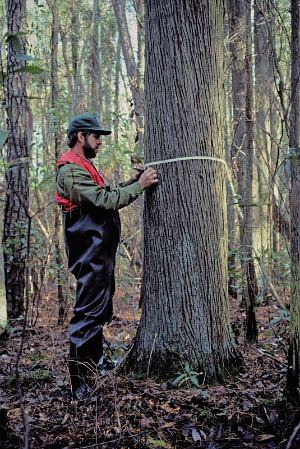
 保育與休閒部
保育與休閒部 保育。保護。享受。
 保育與休閒部
保育與休閒部  目錄
目錄泥炭地大西洋白雪松森林
In Virginia, these coniferous forests are confined to saturated, oligotrophic, Coastal Plain peatlands. Peatland Atlantic White-Cedar Forests are endemic to terraces of the Embayed Region of extreme southeastern Virginia and northeastern North Carolina. Habitats are non-riverine wetland flats with deep organic soils (e.g., Great Dismal Swamp, Cities of Suffolk and Chesapeake) and remote peat flats beyond the range of wind-tidal flooding along the North Landing River (City of Virginia Beach). Atlantic white-cedar forests usually occupy relatively wet peatlands subject to infrequent catastrophic fires. Dense, even-aged stands become established when such fires remove most vegetation and debris, exposing suitable seedbeds. Throughout their maturation, these stands accumulate extensive dead wood and inflammable duff, making them increasingly susceptible to another stand-killing fire. Atlantic white-cedar (Chamaecyparis thyoides) dominates the overstory, sometimes with red maple (Acer rubrum), swamp tupelo (Nyssa biflora), or pines (Pinus serotina and Pinus taeda) as minor associates. Red bay (Persea palustris), sweetbay magnolia (Magnolia virginiana var. virginiana), sweet pepperbush (Clethra alnifolia), big gallberry (Ilex coriacea), inkberry (Ilex glabra), shining fetterbush (Lyonia lucida), and poison ivy (Toxicodendron radicans var. radicans) are common small trees and shrubs. Cinnamon fern (Osmundastrum cinnamomeum) and Virginia chain fern (Woodwardia virginica) are common herbs, while (Sphagnum spp.) and other mosses abundantly cover the ground.

泥炭地大西洋白雪松森林在花卉上與池塘松樹林和波科辛,以及混合常綠類型的非河流沼澤森林相似。它們不同的是在過大樓的主導地位和較低的灌木密度,以及與以前在長時間回復期間遭受災難性火災的大型泥土的關聯性。泥炭地大西洋白雪松森林在全球範圍內是罕見的,現在通過大量的伐木和消除火災減少了它們以前分佈的小殘留物。由於這些干擾和大規模的溝渠,大荒沼的許多舊樹木被轉化為非河流沼澤森林,主要是紅楓和沼澤土木。大西洋白雪松是稀有蝴蝶赫塞爾的毛條(Mitoura hesseli)的幼蟲宿主,它已被記錄在大荒沼澤。
參考文獻:戴貝爾和戴(1977),戴(1985),迪恩(1969),弗萊明和穆爾黑德(1998),弗羅斯特(1995),史蒂文斯和帕特森(1998),火車和戴(1982)。 © DCR-DNH, Caren Caljouw.
© DCR-DNH, Caren Caljouw.

 下載下面列出的每種社群類型的組成摘要統計資料表。
下載下面列出的每種社群類型的組成摘要統計資料表。

